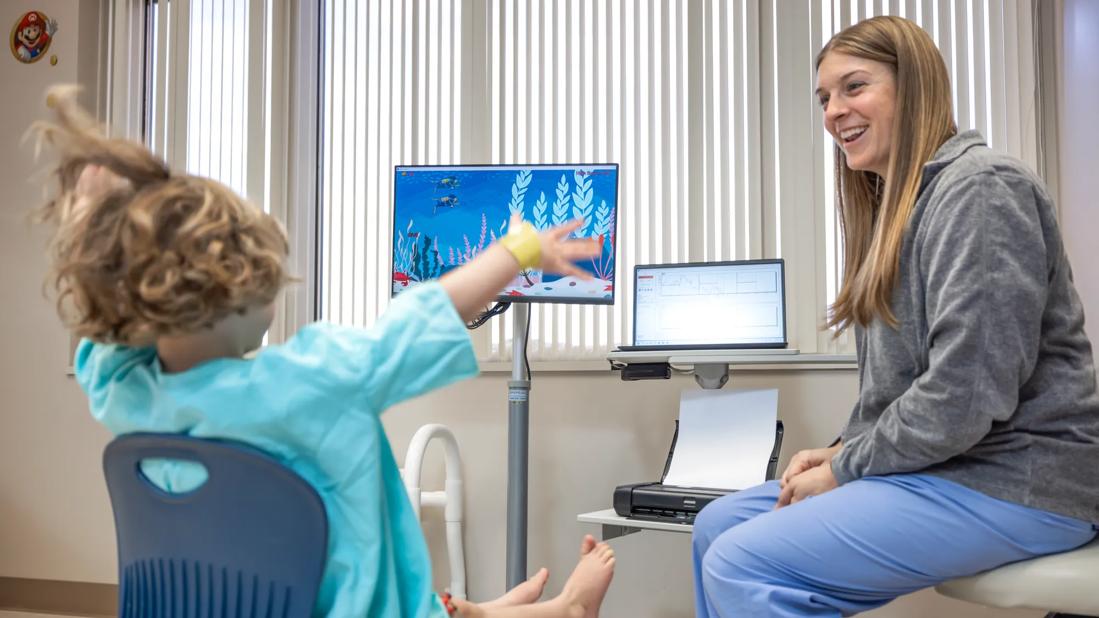When to refer your patient and other considerations for care

Voiding dysfunction is a very common problem in children, accounting for an estimated 40% of visits to pediatric urology. Biofeedback therapy is one of the many tools available to providers for the management of pediatric voiding dysfunction.
Advertisement
Cleveland Clinic is a non-profit academic medical center. Advertising on our site helps support our mission. We do not endorse non-Cleveland Clinic products or services. Policy
Lynn Woo, MD, Section Director of Pediatric Urology at Cleveland Clinic, explains, “Biofeedback therapy is a noninvasive, child-friendly approach to help target the pelvic floor muscle groups and teach children how to isolate and control these muscles,” she says. “It can aid in proper relaxation and contraction, which can help improve a number of urinary symptoms including urgency, frequency, involuntary leakage and incomplete bladder emptying.”
The video game-inspired platform allows providers, patients and their families to visualize the child’s muscle activity in real-time through adhesive sensors affixed to the child’s skin. Exercises and games are then “played” by active contraction and relaxation of the pelvic muscles. The colorful graphics and achievement of various tasks motivate kids to reach muscle activity goals. In doing this, they are retraining these muscle groups and learning how to store and empty urine normally.
The technology can be individualized based on the type of voiding dysfunction, the age of the patient, and their attention span.
Biofeedback in children is effective, with data showing that more than 50% of patients have improved symptoms with treatment. While not every patient may experience the same amount of success with the program, it can provide some helpful tools for children and their families struggling with voiding problems and give them a way to be proactive in improving their symptoms.
The term “voiding dysfunction” encompasses a number of symptoms and common urinary complaints, including recurrent urinary tract infections, incontinence, and incomplete or difficult bladder emptying.
Advertisement
“We often take for granted how our bodies control urination, since it is considered an automatic process that we learn with toilet training,” Dr. Woo explains. “But storing and emptying urine properly is a complex pathway involving an elastic bladder, normal sensation of bladder fullness, and appropriate pelvic muscle control.”
Voiding dysfunction is learned abnormal behavior in which the normal coordination is disrupted, she says. “Sometimes, this is due to an initial infection that causes pain or relates to a history of constipation and discomfort in passing hard stools. Children then adopt withholding behaviors, which lead to involuntary contraction of their pelvic floor muscles at the wrong times,” explains Dr. Woo. Once this behavior is in place, it can create a vicious cycle that leads to poor emptying, urine accidents, and more infections.
All children with suspected voiding dysfunction need a comprehensive evaluation, including a complete patient history, urinalysis, and potentially imaging or functional studies to determine an underlying voiding dysfunction. Cleveland Clinic’s pediatric urology team performs a thorough assessment for each patient, provides education for families and will devise an individualized treatment plan that might include behavioral modifications (termed “urotherapy”), medications, and pelvic floor therapy in the form of biofeedback.
“While some patients may require medicines or more invasive interventions, the vast majority can improve their symptoms with urotherapy and/or biofeedback exercises. I think parents and providers alike would generally prefer to begin with conservative measures and, if possible, avoid drugs or surgery,” notes Dr. Woo.
Advertisement
Recurrent urinary tract infections or lack of consistent urinary control after the age of 7 may be signs of voiding dysfunction, and these children should have additional evaluation. She stresses, “It’s important to be proactive about these issues to prevent long-term urinary tract complications.”
Advertisement
Advertisement

A closer look at the impact on procedures and patient outcomes

Experts advise thorough assessment of right ventricle and reinforcement of tricuspid valve

Study also finds that 26% of children with cancer have mutations in DNA repair genes

A closer look at current uses and future opportunities

Experts are challenging the one-size-fits-all paradigm

Quality improvement project addresses unplanned extubation

Cardiac imaging substudy is the latest paper originating from the VANISH trial

Consortium makes key recommendations to improve prevention practices